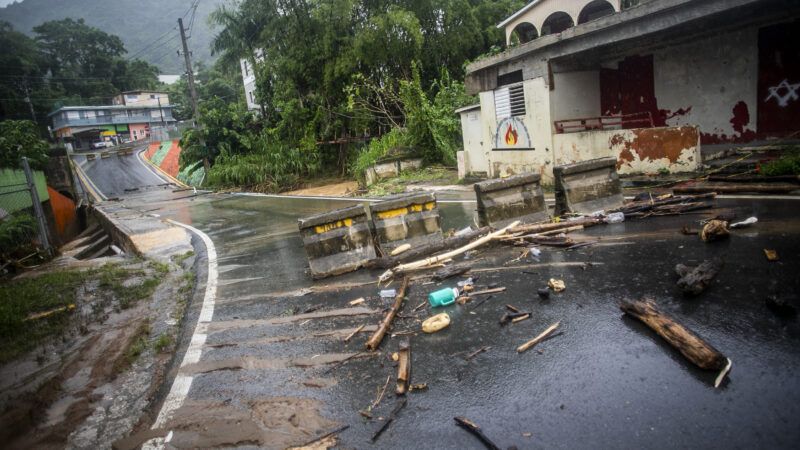Where Did Puerto Rico's Disaster Relief Go?
After a Category 1 hurricane made landfall Sunday, a million Puerto Rican households are still without power.

Almost five years ago to the day, Hurricane Maria wrought catastrophic damage on Puerto Rico. Now another hurricane has caused an island-wide power outage, provoking new questions about the use of billions in federally-allocated disaster relief funds.
One million households are without power in Puerto Rico after Hurricane Fiona, then a Category 1 storm, made landfall on the island's southwestern coast Sunday afternoon. These outages began even before the storm came ashore, with power lines coming down as the storm's gusts reached the island. Puerto Rico's governor, Pedro Pierluisi, has described the damage as "catastrophic" and many remain impacted by mudslides and widespread flooding after parts of the island received nearly 3 feet of rain.
While officials have voiced confidence that electricity would be restored quickly, the blackout comes amid a wave of scrutiny: Billions of dollars were allocated by the federal government to rebuild Puerto Rico following Hurricane Maria and recovery efforts are projected to cost U.S. taxpayers another $50 billion, according to Federal Emergency Management Agency (FEMA) estimates. But corruption by FEMA officials in Puerto Rico has slowed down progress dramatically. Back in 2019, FEMA's deputy regional administrator in charge of Maria recovery was indicted as part of a $1.8 billion bribery scheme involving an Oklahoma-based electric company. Officials on the island were also indicted for allegedly steering $15 million in federal rebuilding contracts to preferred contractors. And the Jones Act shares some of the blame since its restrictions on shipping to U.S. territories like Puerto Rico drive up costs for imported products significantly and delay the arrival of necessary supplies during emergency situations.
Congress has begun to ask questions about how exactly that money has been spent over the last five years. At a subcommittee hearing last Thursday of the House Committee on Transportation and Infrastructure, officials from the Government Accountability Office told lawmakers that 80 percent of the territorial government's disaster relief spending has gone to emergency relief, such as removing debris, dwarfing investments in the island's infrastructure. These experts also confirmed to lawmakers that only 19 percent of relief money allocated has been spent, forcing some lawmakers to ask when Puerto Rican officials plan on spending the remaining funds and moving forward on infrastructure improvements.
The blackouts have also returned attention to Puerto Rico's embattled electric company, LUMA Energy, a Canadian-owned firm that took over the administration and maintenance of the island's electric grid after Puerto Rico's state-owned electric company declared bankruptcy in the aftermath of Hurricane Maria. Since taking over in 2018, LUMA has faced criticism for its slow response to blackouts, which have become more frequent and dramatic since they assumed control of the grid. Under LUMA management, work to weatherize and maintain the electric grid has also stalled as energy prices have spiked dramatically.
These criticisms came to a head in August, when another wave of blackouts prompted the island's non-voting member of the U.S. House of Representatives, Jenniffer González, to call for an end to LUMA's contract with the Puerto Rican government. Pierluisi, who up until then had defended the government's contract with LUMA, also denounced the company's practices and called on LUMA to make significant changes to its practices and pace of improvements.
The power grid's failure also takes on an additional significance given officials' previous public statements attesting to the grid's strength. Back in 2020, officials had assured members of Congress that Puerto Rico's electric grid could withstand hurricane conditions. "The answer is yes," José Ortiz, the executive director of the Puerto Rico Electric Power Authority, testified when pressed about the grid's readiness. "We have five times the inventory we had before Maria."
With a Congressional hearing on the LUMA energy contract now scheduled for later this week, Puerto Rican officials will have to answer why that increased inventory did little to stop the blackouts.
Show Comments (49)